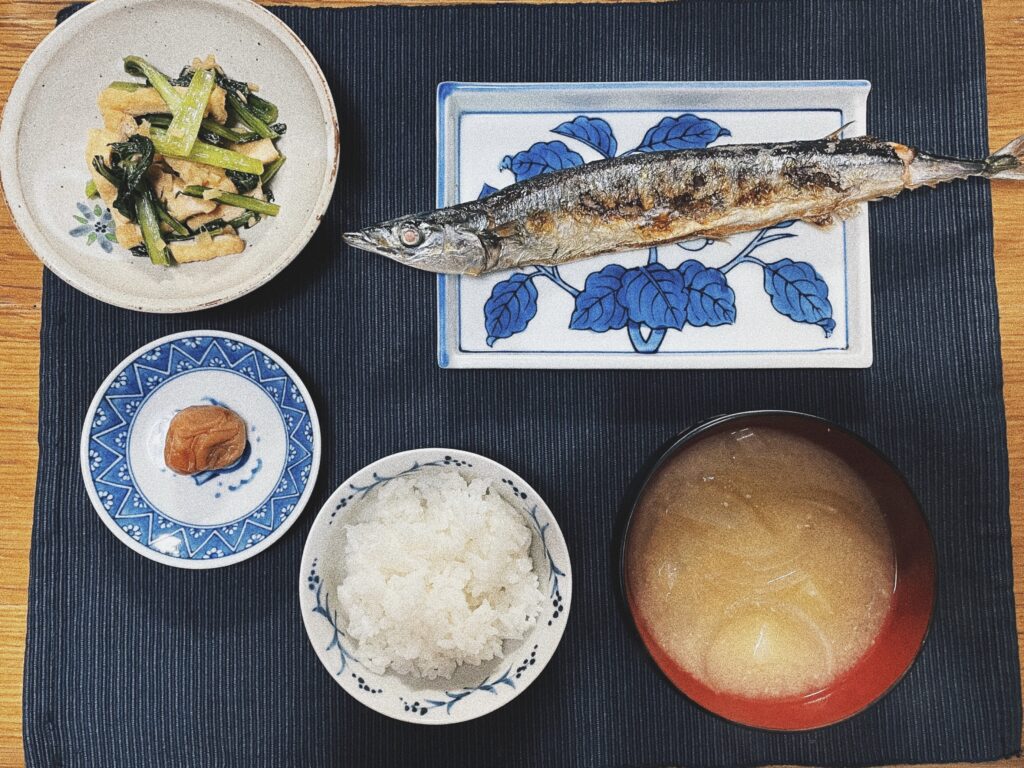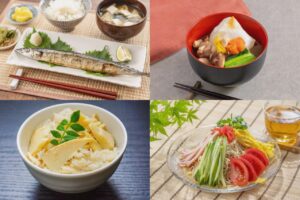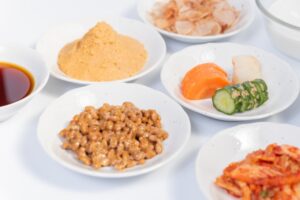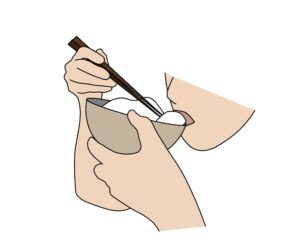Japanese food culture is characterized by its deep respect for nature, emphasizing the use of seasonal ingredients to bring out the best flavors at the right time of the year. It focuses on balance, not only in terms of nutrition but also in the harmony of taste, texture, and presentation. Traditional Japanese cuisine values the natural flavors of ingredients, using minimal seasoning to enhance, rather than overpower, their essence. Renowned for being healthy, aesthetically pleasing, and deeply rooted in centuries-old traditions, Japanese food culture reflects a philosophy of simplicity, mindfulness, and appreciation for both food and the people who prepare it.
Traditional Japanese Cuisine (Washoku)
Washoku (和食), or traditional Japanese cuisine, was recognized as a UNESCO Intangible Cultural Heritage in 2013.
The foundation of Washoku is the “Ichiju-Sansai (一汁三菜)” meal structure, which ensures a nutritionally balanced diet.

Ichiju-Sansai (One Soup, Three Dishes) Structure
- Rice (Staple food)
- Soup (Miso soup or clear broth)
- Main dish (Fish, meat, or tofu-based dish)
- Two side dishes (Vegetables, pickles, or small dishes)
Importance of Seasonal Ingredients (Shun, 旬)
Japanese food culture values seasonal ingredients and eating in harmony with nature.
Seasonal foods are believed to have the best flavor and nutritional value at their peak.
- Spring: Bamboo shoots, cherry blossom sea bream, nanohana (rape blossoms)
- Summer: Watermelon, eel, edamame
- Autumn: Matsutake mushrooms, Pacific saury (sanma), freshly harvested rice
- Winter: Crab, fugu (pufferfish), daikon radish

Unique Fermented Foods in Japan
Japanese cuisine includes many fermented foods that offer health benefits such as improved digestion and gut health.
These fermented foods not only enhance umami (savory taste) but also contribute to a long and healthy life.
- Miso : Used in miso soup and various dishes
- Soy sauce : Essential seasoning in Japanese cooking
- Natto : Fermented soybeans, rich in probiotics
- Tsukemono : Japanese pickles, such as umeboshi (pickled plums)

Unique Aspects of Japanese Food Culture
Distinctive Japanese Food Practices & Dishes
- Onigiri (Rice balls): A simple yet beloved Japanese soul food
- Sushi : One of Japan’s most famous dishes worldwide
- Kaiseki Cuisine (懐石料理): A multi-course traditional Japanese meal, often served in fine dining settings
- Bento Culture (お弁当): A tradition of homemade or store-bought boxed meals (Character-themed “kyaraben” bento is also popular)
- Ramen & Japanese-style Curry: Foreign influences adapted into uniquely Japanese dishes
Japanese cuisine places great importance on presentation, tableware, and the art of hospitality (“Omotenashi”), making dining an aesthetic and cultural experience.
Japanese Dining Etiquette & Mindset
Japanese food culture places strong emphasis on gratitude and respect for food.
Before eating → “Itadakimasu” (いただきます) (A phrase expressing gratitude for the food and those who prepared it)
After eating → “Gochisousama deshita” (ごちそうさまでした) (A phrase thanking the cook and the meal itself)
Other common dining etiquette includes:
✔ Not wasting rice grains (finish every grain in your bowl)
✔ Holding bowls while eating (especially rice and miso soup bowls)
✔ Using chopsticks properly (avoiding improper manners such as passing food from chopstick to chopstick or sticking chopsticks upright in rice)

Comments